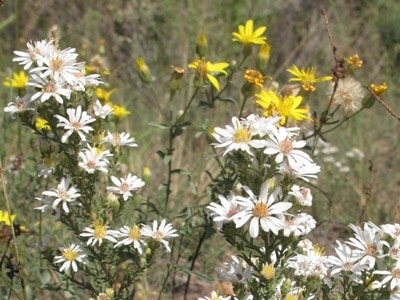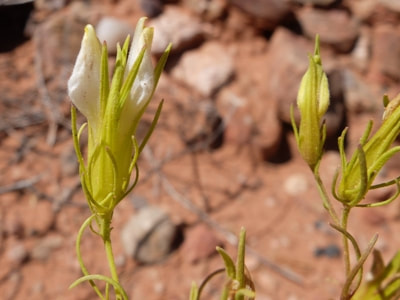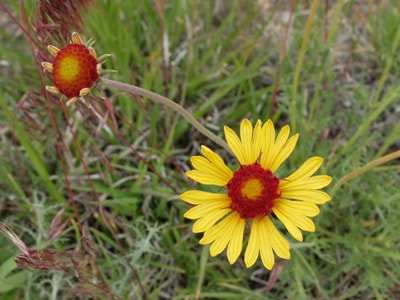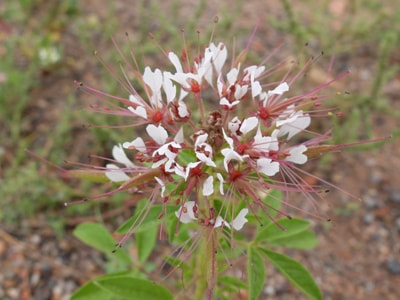White Heath Aster, Many-flowered Aster,Symphyotrichum ericoides,Sunflower Family (Asteraceae)9/27/2019 Found in dry to moist soil, roadsides
Seen blooming in September by Hwy 554 You know that summer is coming to an end when the asters start blooming. The purple Tansyasters and Golden Asters (in photo) are in abundance and bright amongst them is the White Heath Aster. It grows to 3 feet tall with twisted, woody stems and narrow, pointed leaves, as in heaths. The flower heads are smaller than the other asters, about ½ inch across. The centers of the flower heads turn reddish-brown with age. As many as 100 flowers on a plant grow in a crowded, cylindrical spike or a one-sided cluster. Asters were used by several Native American tribes for a variety of purposes. White Heath in particular was used as a smoke-producing plant in sweat baths, for curing snake bites and for reviving an unconscious person. Source. If you are trying to identify a different flower then you can check what other flowers bloom this month. If you cannot identify a flower from the website send a photo and where you took it to contact@rockymountainsflora.com. Read online for tips.
0 Comments
Found in sandy areas, openings
Seen blooming in August and September in Red Wash Canyon A wiry, bushy plant growing to 18 inches high in colonies of many plants with finely divided, feathery leaves. Both leaves and flowers are covered in fine hairs. The cream to purplish beak-shaped flowers grow in tight clusters, usually pairs, at the tips of the branches. Although the flowers do not seem to open fully there is a tiny gap at the top to allow pollinators in. A decoction of the plant was used for syphilis, menstrual pain, prolapses of the uterus, and by men for leg or body aches; it was also used for ceremonial purposes. Source. If you are trying to identify a different flower then you can check what other flowers bloom this month. If you cannot identify a flower from the website send a photo and where you took it to contact@rockymountainsflora.com. Read online for tips. Found in sandy areas
Seen blooming in September on the Lemitas Trail in Santa Fe NF Othake grows from 4 to 24 inches high with a slender, sticky-hairy stem with sand stuck to it so the plant disappears, except for its showy flowers. Leaves are few and narrowly lance-shaped. Flowers are an inch across at the end of the branches with only five petals which are divided into three lobes. The name Palafox honors Juan de Palafox y Mendoza (1600-1659), founder of the University of Mexico and bishop of Puebla, but another website says it is named after José de Palafox y Melzi, Duke of Saragossa (1776–1847), a Spanish captain-general in the war against the invading armies of Napoleon. Quite a different era and personality. Yo no se. If you are trying to identify a different flower then you can check what other flowers bloom this month. If you cannot identify a flower from the website send a photo and where you took it to contact@rockymountainsflora.com. Read online for tips. Found in dry meadows
Seen blooming from June to September in Red Wash Canyon Blanket Flowers will look familiar because they are often included in wildflower seed mixes but they are native plants. The Red Dome Blanket Flower blooms from June to October and grows to about one foot in height in dense tufts. Leaves are mostly around the base and are cut deeply into narrow teeth. Petals have three lobes and are usually yellow but can be streaked with purple. The dried seeds can be ground into a powder then kneaded into seed butter and spread on bread. Traditionally the plant was used as a diuretic, taken to give relief from painful urination. A decoction of the plant was taken to treat heartburn and nausea, and a poultice applied externally for the treatment of gout. It was also used for bewitchment. Source. If you are trying to identify a different flower then you can check what other flowers bloom this month. If you cannot identify a flower from the website send a photo and where you took it to contact@rockymountainsflora.com. Read online for tips. Redwhisker Clammyweed, Clammyweed,Polanisia dodecandra ssp. Trachysperma,Cleome Family (Cleomaceae)8/30/2019 Found in disturbed sandy areas
Seen blooming in August at Abiquiu Lake Clammyweed gets its name from the sticky or clammy feeling when handling the plant. Redwhisker refers to the many long red stamens. It grows to 2 feet tall with leaves divided into three leaflets that have an unpleasant smell if crushed. The spherical flower heads are showy and made up of about 20 flowers with four white/cream petals and 12 long reddish/purple stamens that stick up beyond the petals. Seed pods are 2 to 3 inches long and upright. Pueblo tribes boiled the young, tender leaves with corn and they gathered the leaves and dried them for use during the winter. The Isleta rolled the dried leaves in corn husks to make ceremonial cigarettes. The Tewa ground the whole plant and mixed it with water for a drink that was taken internally for stomach problems. Source. If you are trying to identify a different flower then you can check what other flowers bloom this month. If you cannot identify a flower from the website send a photo and where you took it to contact@rockymountainsflora.com. Read online for tips. |
AuthorI am Marilyn Phillips, a native of England, whose love of nature and the outdoors from childhood brought me by a circuitous route to Crested Butte, Colorado in 1993 and 16 years later to northern New Mexico. My exploration of the many trails in these areas, my interest in wildflowers and photography, and career in computer system design came together in this creation. If you have any corrections, comments or questions, please contact me by email. Archives
September 2024
Categoriescopyright © 2020
|







 RSS Feed
RSS Feed